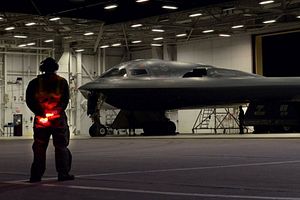The U.S. Air Force dispatched a B-2 Spirit stealth bomber from Whiteman Air Force Base in Missouri to the Asia-Pacific region this weekend to demonstrate the United States’ commitment to its regional allies amid growing tensions on the Korean Peninsula, U.S. Strategic Command officials said on October 28.
The B-2 Spirit’s long-range patrol was conducted to “familiarize aircrew with air bases and operations in different geographic combatant commands, enabling them to maintain a high state of readiness and proficiency,” a U.S. military statement reads. “These missions validate our always-ready global strike capability and are a visible demonstration of commitment to our allies and enhancing regional security.”
The bomber patrol was most likely intended to reassure U.S. regional allies ahead of U.S. President Donald Trump’s 12-day trip through Asia, where he is scheduled to visit Japan, South Korea, China, Vietnam, and the Philippines. North Korea, which continues to test ballistic missiles and nuclear warheads, will be one of the president’s top priorities during the trip.
“I cannot imagine a condition under which the United States would accept North Korea as a nuclear power,” U.S. Secretary of Defense James Mattis said on October 28 during a visit to South Korea. “Any use of nuclear weapons by the North will be met with a massive military response, effective and overwhelming,” he added.
The B-2 Spirit is a subsonic strategic stealth bomber that be armed with both conventional and thermonuclear weapons. It has been specifically designed for penetrating advanced anti-aircraft defenses. The bomber has a range of over 11,000 kilometers (6,900 miles) on internal fuel and 19,000 kilometers (12,000 miles) with one midair-refueling.
The bomber can carry a nuclear or conventional weapons payload of more than 18,000 kilograms (40,000 pounds). It first entered the U.S. Air Force’s operational fleet in 1993. The U.S. Air Force currently operates 20 B-2s. The last time a B-2 bomber flew near the Korean Peninsula was in 2013.
“U.S. Strategic Command sent two B-2 Spirit bombers for a long-duration, round-trip training mission from Whiteman Air Force Base, Mo., to the Republic of Korea March 28 as part of the ongoing bilateral Foal Eagle training exercise,” the U.S. military said at the time.
The U.S. Air Force has routinely been stationing bombers in Guam since 2004 including B-2s, B-1Bs, and B-52Hs.
The United States is also at the moment operating three U.S. Nimitz-class supercarriers in the U.S. 7th Fleet’s area of operations (AOO). “The 7th Fleet is the Navy’s biggest forward-deployed fleet, with its area of operations stretching from the International Date Line to the India-Pakistan border, and from the Kuril Islands in the north to the Antarctic in the south,” I explained last week.

































